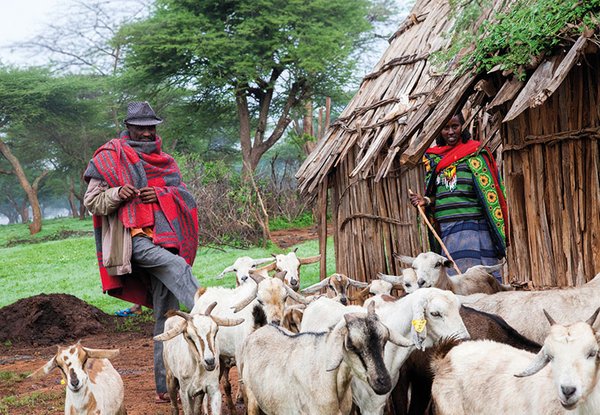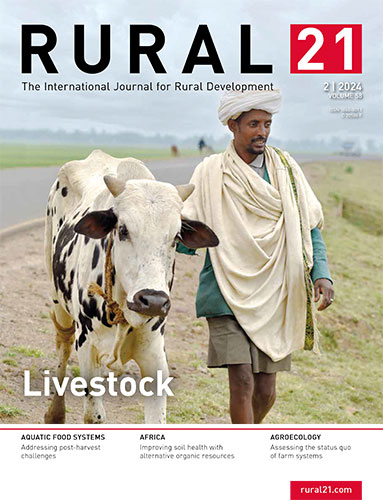 Download this article in magazine layout
Download this article in magazine layout
- Share this article
- Subscribe to our newsletter
Livestock and sustainable food systems – a complex relationship
Livestock systems, like any system, are made up of interacting components and are categorised according to specific criteria. Based on five such criteria, Seré and Steinfeld identified two types of livestock systems and four sub-types within four agroecological zones world-wide: 1) Solely livestock: 1a) landless or 1b) grassland-based, and 2) Mixed (crop-livestock) systems: 2a) in rainfed zones or 2b) irrigated zones. In these systems, livestock plays a key role, interacting with grasslands and croplands. Cropping and livestock practices can either preserve or alter the landscape, with potential positive or negative effects. Poor practices can threaten both the environment and its services and climate. Often, the negative impacts of livestock, supported by extensive evidence, are intuitively associated with high animal numbers and intensive and industrial farming practices. However, research also indicates that too few animals or low stock densities can be detrimental to the environment.
The adverse effects of livestock systems are not necessarily due to the presence of livestock itself, but rather to inadequate management that disrupts the agroecosystem balance. One of the major challenges lies in identifying root causes that harm agri-food systems, which include livestock production, and addressing them without causing further, more severe problems.
A look at climate change and natural resource consumption
Of the seven greenhouse gases (GHGs) targeted by the Kyoto Protocol, the primary GHGs emitted by the agricultural sector are carbon dioxide (CO2), methane (CH4) and nitrous oxide (N2O). In 2020, the global food system was responsible for 31 per cent of all GHG emissions caused by humans. Deforestation and enteric fermentation in ruminants are the top two sources of these emissions within the food system, accounting for 36 per cent of the food system’s total GHG emissions. The livestock sector alone was estimated to contribute 47 per cent of the food system’s GHG emissions in 2020 and 14.5 per cent of total global anthropogenic GHG emissions. Given that methane is a significant GHG with a higher global warming potential than CO2 and a shorter atmospheric lifespan, the livestock sector is seen as a major lever to rapidly reduce GHG emissions from the food system, compared to other sectors.
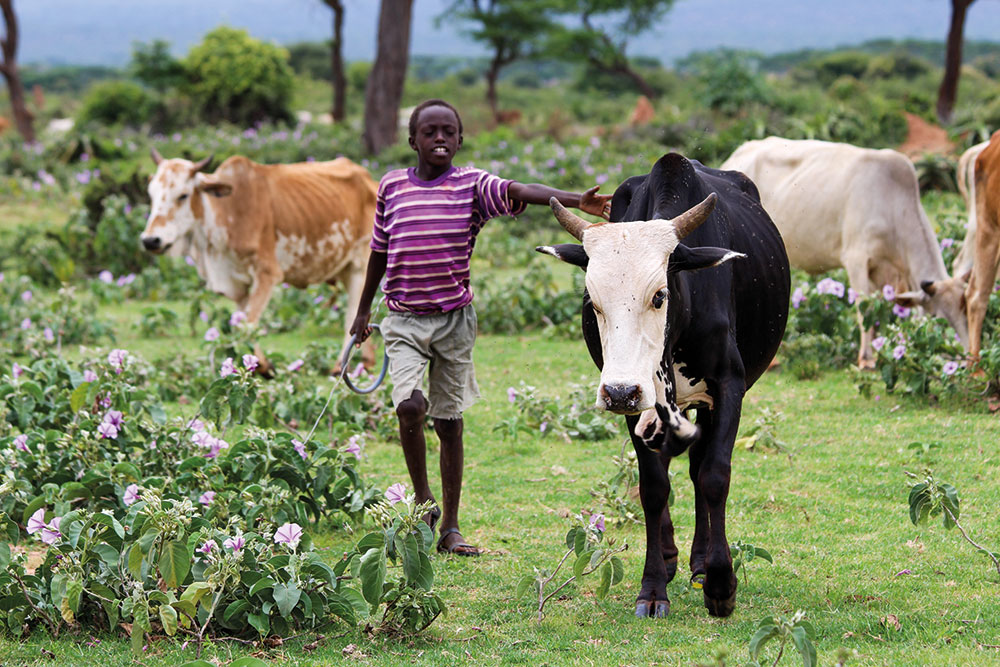
Photo: Camille Hanotte/ ILRI
Livestock and agriculture not only contribute to climate change but are also affected by it. Under the conservative scenario of 1.5–2° C temperature increase, it is estimated that 5 per cent of the world’s livestock production (compared to 8 per cent for crops) will be outside the safe climate range by 2090. If temperatures increase by more than 2° C by 2090, 34 per cent of the world’s livestock production (versus 31 per cent for crops) could be at risk. This will predominantly impact South and Southeast Asia, as well as sub-Saharan Africa, making vast areas currently suitable for livestock unsuitable.
Livestock is often criticised for its intensive land use, in competition with food produced for human consumption, its significant water footprint and its impact on biodiversity. However, a detailed examination reveals that while livestock uses about half of the world’s agricultural land, this is mostly grassland, which is not easily, or not at all, convertible to crop land. Moreover, the livestock world diet is largely composed of feedstuff that is not suitable for humans. Similarly, it is important to note that over 90 per cent of the water used in beef production is rainwater, making it less reliant on irrigation compared to many crops, such as, for example, nuts. While there are instances where livestock compete with crops for land, the issues of water and land-use efficiency are complex. These examples illustrate that the role of livestock in agriculture cannot be addressed in a simplistic manner. Moreover, it has to be considered that livestock does not have a solely extractive role in agricultural and food systems: it contributes positively to the agri-food system and society in various ways.
A parameter with an important influence on livelihoods, nutrition and health, and ecosystems
Livestock offer a wide range of goods and services to humans. Approximately one billion people globally rely directly on livestock for their livelihood and food security. Animals and their products can be sold, traded or even used as collateral for loans and credit, serving as a form of savings, insurance and social security. While many livestock-related products and services are monetarisable, others, like risk mitigation for farmers – particularly in the Global South – are harder to value.
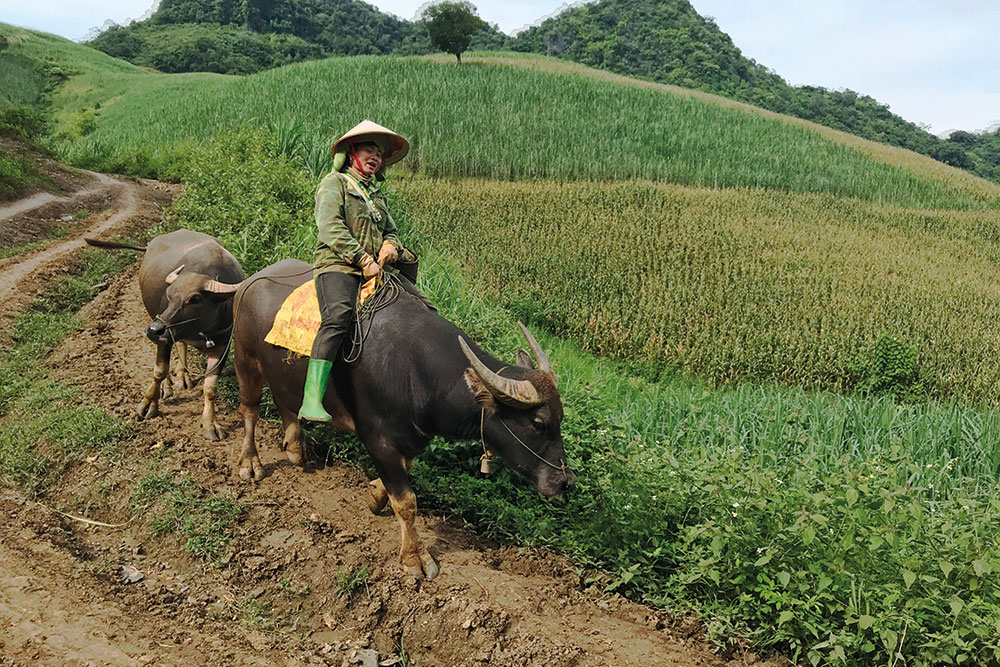
Photo: Stevie Mann/ ILRI
Livestock is the third most significant source of income for farmers world-wide, following crop and non-farm activities. For women in developing countries, especially those in poverty, small livestock is a crucial asset, enabling them to earn cash (also see article "Unleashing the potential of women livestock keepers"). It is estimated that women make up two-thirds of the 600 to 800 million poor livestock keepers in the world. In many places, women lack access to traditional collateral like land titles, making livestock a key avenue for economic and social empowerment. Beyond providing material goods and services, animals hold significant religious or cultural importance in our daily lives. We see this in our food habits, rituals and ceremonies during important life events, such as births, entering adulthood, weddings and even funerals. These cultural dimensions can sometimes hinder efforts to bring about system-wide changes.
Animal-source foods have been part of human diets for millions of years. Livestock currently provide 18 per cent of global calories and 39 per cent of protein consumption. The consumption of livestock-derived foods varies across regions. At 69 kg/capita/year, meat consumption is highest in industrial countries with a high income and is lowest in developing countries, at 26.2 kg. Thanks to the high density, composition and bioavailability of their nutrients, these livestock-derived foods are well-suited for people with special nutrition needs and limited food-intake capacity, including pregnant women, young children and the elderly. However, excessive consumption of animal-source foods, especially in processed forms, contributes to malnutrition and health issues such as obesity, increased risk of cardio-vascular diseases and specific forms of cancer. Living close to animals and consuming animal products also entail further health risks, such as zoonotic and foodborne diseases. On the positive side, keeping animals, including livestock, can have beneficial impacts on mental health.
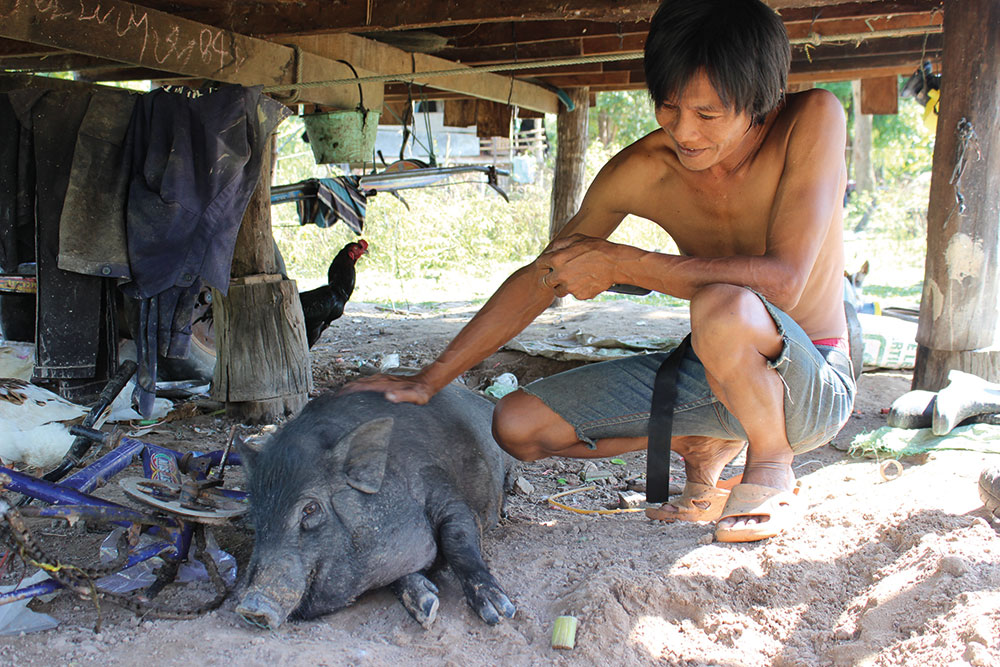
Photo: Chi Nguyen/ ILRI
One global challenge is to reduce the consumption of livestock-derived foods in areas where it is in excess with regard to nutritional recommendations and increase it where it is in deficit. The UN Food and Agriculture Organization (FAO) sees several avenues to reach these goals, among others a reduction of the consumption of animal-source food and improved efficiency thanks to more productive animals.
Livestock directly contribute to plant production in several ways. First, animals provide manure, which enriches soil health. Second, in many Global South countries, livestock play a crucial role as draught animals for land cultivation. These direct contributions are essential for sustainable agriculture. However, there is also an indirect benefit: including temporary pasture in crop rotation enhances overall yields. This contribution is often overlooked when advocating for more plant-based diets.
Beyond cropping systems, livestock also have positive environmental impacts. Natural grasslands, covering a significant portion of the world’s agricultural land, store substantial carbon. Proper grazing management, adapted to the local conditions and considering factors like stocking rate, adapted species and breeds, and timing, can prevent overgrazing, which lead to desertification, or under-grazing leading to bush encroachment and the risk of wildfires. Well-managed, natural grasslands offer additional important ecosystem services, including water regulation, erosion control and flood prevention, and support for diverse flora and fauna.
Addressing the trade-offs in livestock systems
The multifaceted aspects of livestock production reveal its inherent complexity and the trade-offs involved in addressing challenges. To tackle these issues, a systemic approach is essential. Here are some examples of systemic approaches currently employed, particularly in the Global South and, increasingly, world-wide, to navigate the complexities of livestock production.
Promoting integrated crop-livestock systems and circular economy
In the Global South, many smallholders continue to rely on integrated crop-livestock systems. These systems, once common in the Global North until World War II, face pressure to industrialise due to growing food demand, especially for livestock-derived foods, particularly in the Global South. To enhance food system efficiency, we can reconnect crop and livestock production at farm, local or regional levels. By using crop residues and by-products from the agri-food industry as feedstuff, or manure as fertiliser and energy production, as well as through optimised natural feeding practices, we can simultaneously benefit humans and respect planetary boundaries. Adopting (again) a circular approach and reviving agroforestry systems offer promising avenues for sustainable transformation of food systems.
One Health
The concept of One Health, championed by the World Organisation for Animal Health (WOAH), applies a systemic approach. It bridges disciplines, involves various stakeholders and integrates the various dimensions of livestock management by considering their impact on human, animal and environmental health. This approach has been successfully employed in many countries to combat antimicrobial resistance (AMR) across humans, animals and agriculture.
True cost accounting
True cost accounting of food offers a way to shift food purchasing and consumption habits. It involves assessing and monetising the full spectrum of costs related to food production and consumption: economic, environmental, social and health impacts. However, true cost accounting still faces limitations, particularly in accurately accounting for carbon stocks and soil organic build-up.
Collaboration is key
The transformation of our food system is essential for resilience, sustainability and inclusivity, while respecting Earth’s boundaries and ecosystems. Simultaneously, we must enhance food system efficiency to improve and ensure global food security. Among the critical components, the livestock sector – alongside agriculture, food processing and logistics – plays a pivotal role. It supports livelihoods, health and nutrition for people and ecosystems.
However, challenges lie ahead. We must move beyond current blueprints and simplistic approaches, addressing inevitable trade-offs. Achieving a systemic understanding of the food system – its trade-offs and interdependencies – requires research and development efforts from both public and private entities. These efforts should focus on sustainable production systems and supply chains applicable within the given context.
Market demand acts a decisive force. Raising consumer awareness about health, social, economic and environmental issues is crucial. Predictable and fair market mechanisms, guided by transparent regulatory frameworks, empower all food-system actors. This calls for coordinated measures by public and private entities.
Collaboration among diverse stakeholders is key. No single actor can transform food systems alone. Multi-stakeholder platforms, initiatives and networks globally drive change. Recommendations from these platforms must inform global guidelines, national policies, industry standards and educational programmes. Yet, the policy environment matters most. Supportive governance structures, breaking down sectorial silos and evidence-based decision-making fuel food system transformation. Together, we can achieve sustainable food systems and progress towards the 17 Sustainable Development Goals.
Nancy Bourgeois Lüthi is a lecturer and researcher in International Livestock Systems at the School of Agricultural, Forest and Food Sciences (HAFL) at Bern University of Applied Sciences in Switzerland.
Nancy Bourgeois Lüthi is a lecturer and researcher in International Livestock Systems at the School of Agricultural, Forest and Food Sciences (HAFL) at Bern University of Applied Sciences in Switzerland. Contact: nancy.bourgeois@bfh.ch
Angela Wade is communication manager at HAFL.
Martijn Sonnevelt is the Executive Director of the World Food System Center at ETH Zurich, Switzerland. Contact: nancy.bourgeois@bfh.ch
This article draws on research conducted by the Swiss National Committee to the FAO (CNS-FAO), an advisory body to the Federal Council, published in a discussion paper in January 2024.
References:
Bengtsson J., Bullock J.M., Egoh B., Everson C., Everson T., O'Connor T., O'Farrell P.J., Smith H.G. and R. Lindborg, 2019. Grasslands—more important for ecosystem services than you might think. Ecosphere 10(2): e02582. https://doi.org/10.1002/ecs2.2582
FAO, 2012. Invisible Guardians. Women manage livestock diversity. FAO Animal Production and Health Paper No. 174. FAO, Rome, Italy, 74 pp. www.fao.org/3/i3018e/i3018e00.pdf
FAO, 2018. World Livestock: Transforming the livestock sector through the Sustainable Development Goals. Rome. 222 pp. doi.org/10.4060/ca1201en
FAO, 2022. Greenhouse gas emissions from agrifood systems. Global, regional and country trends, 2000–2020. FAOSTAT Analytical Brief No.50. FAO, Rome, Italy, 12 pp. https://www.fao.org/3/cc2672en/cc2672en.pdf
FAO, 2023a. Methane emissions in livestock and rice systems. Sources, quantification, mitigation and metrics. FAO, Rome, Italy, 352 pp. https://www.fao.org/3/cc7607en/cc7607en.pdf.
FAO. 2023b. Pathways towards lower emissions – A global assessment of the greenhouse gas emissions and mitigation options from livestock agrifood systems. Rome doi.org/10.4060/cc9029en
Gasner A. and P. Dobie (eds.), 2022. Agroforestry: a Primer. Design and management principles for people and the environment
GLEAM, 2022. Global Livestock Environmental Assessment Model (GLEAM) Version 3. FAO, Rome, Italy, 152 pp. www.fao.org/fileadmin/user_upload/gleam/docs/GLEAM_3.0_Model_description.pdf
Herzon I., Raatikainen K.J., Helm A., Rūsiņa S., Wehn S., and O. Eriksson, 2022. Semi-natural habitats in the European boreal region: Caught in the socio-ecological extinction vortex?. Ambio 51: 1753–1763. https://doi.org/10.1007/s13280-022-01705-3
Koch B., Hofer G., Edwards P.J. and W.U. Blanckenhorn, 2013. Biodiversité dans les alpages embroussaillés: Recommandations pour l’exploitation des alpages riches en espèces connaissant des problèmes d’embroussaillement. Agroscope, Rapport ART 769: 1–16. ira.agroscope.ch/fr-CH/publication/32762
Kummu M., Heino M., Taka M., Varis O. and D. Viviroli, 2021.Climate change risks pushing one-third of global food production outside the safe climatic space. One Earth 4(5): 720–729. https://doi.org/10.1016/j.oneear.2021.04.017
Mekonnen M.M. and A.Y. Hoekstra, 2012. A Global Assessment of the Water Footprint of Farm Animal Products. Ecosystems 15: 401–415. doi.org/10.1007/s10021-011-9517-8
Mottet A., de Haan C., Falcucci A., Tempio G., Opio C. and P. Gerber, 2017. Livestock: On our plates or eating at our table? A new analysis of the feed/food debate. Global Food Security 14: 1–8. doi.org/10.1016/j.gfs.2017.01.001
Moustier P., 2006. Déprise agricole et mutations paysagères depuis 1850 dans le Champsaur et le Valgaudemar (Hautes-Alpes). Revue géographique des pays méditerranéens 107: 43-51. https://doi.org/10.4000/mediterranee.461
OECD and FAO, 2022. OECD-FAO Agricultural Outlook 2022-2031. www.oecd-ilibrary.org/agriculture-and-food/oecd-fao-agricultural-outlook-2022-2031_ab129327-e
Robinson T.P., William Wint G.R., Conchedda G., Van Boeckel T.P., Ercoli V., Palamara E., Cinardi G., D'Aietti L., Hay S. and M. Gilbert, 2014. Mapping the Global Distribution of Livestock. PloS one 9(5): e96084. doi.org/10.1371/journal.pone.0096084
Seré, C. and H. Steinfeld, 1996. World livestock production systems: Current status, issues and trends. FAO Animal Production and Health Paper 127. FAO, Rome, Italy. https://www.fao.org/3/w0027e/w0027e.pdf
True Cost Initiative, 2022. TCA Handbook – Practical True Cost Accounting guidelines for the food and farming sector on impact measurement, valuation and reporting. Available at: tca2f.org/wp-content/uploads/2022/03/ TCA_Agrifood_Handbook.pdf
Van Zanten H.H.E., Van Ittersum M.K. and I.J.M. de Boer, 2019. The role of farm animals in a circular food system. Global Food Security 21:18–22. doi.org/10.1016/j.gfs.2019.06.003


